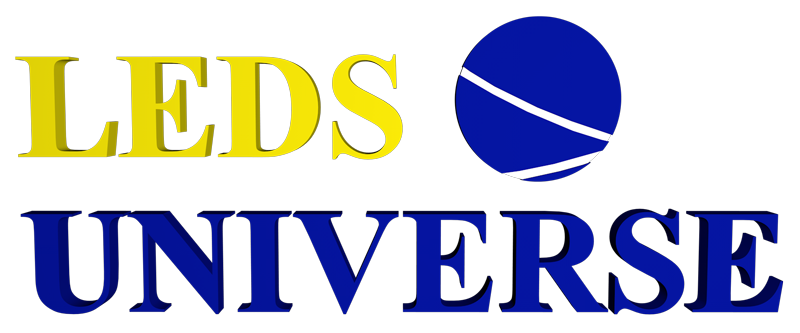1. Why are LED Stadium Lights Key to Good Illumination and Outstanding Game Practice?
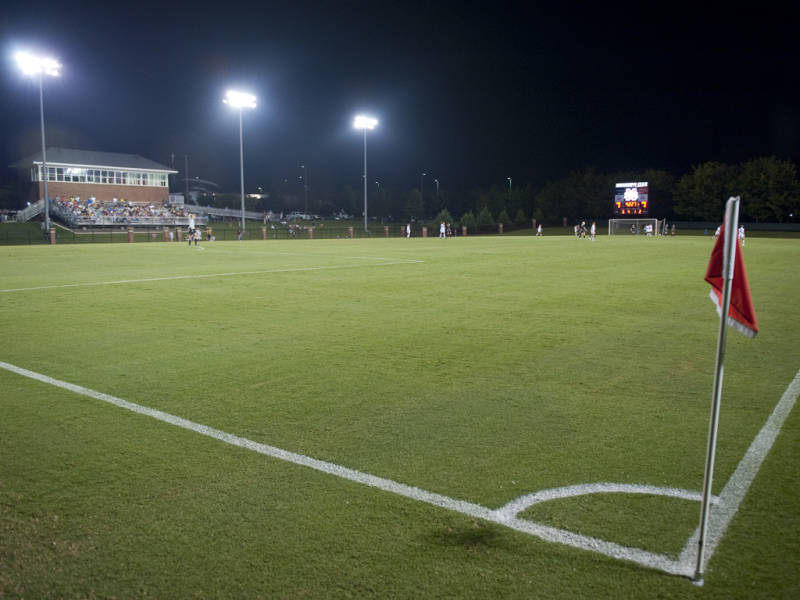 Choosing the type of led stadium lights you are going to install in your arena is not only about focusing on a short-term solution to fix problems you might currently have with the present lighting fixtures, but it should aim as well at improving the future quality of the games played within your venue, while at the same time you make sure that cost and expenses are kept within a limited budget.
Choosing the type of led stadium lights you are going to install in your arena is not only about focusing on a short-term solution to fix problems you might currently have with the present lighting fixtures, but it should aim as well at improving the future quality of the games played within your venue, while at the same time you make sure that cost and expenses are kept within a limited budget.
You can achieve both objectives with LedsUniverse LEDs. They have proven to increase many of our client’s revenues yearly, while the light output (lumen per watt) can be much higher than other high power led. Therefore, choosing the right led fixtures for your stadium is paramount for a prosperous business model.
2. How Much Does it Cost for Lighting Up a Stadium? And What About the Overall Price of a Project Involving LED Sports Lighting for Stadiums?
Well, it really depends on the type of project you have at hands. Mainly, if this area is for: amateur level, semi-professional level, professional level or professional level with TV broadcasting.
Though, for reference, you should expect to spend about $25,000 USD for amateur, $45,000 USD for semi-professional and $90,000 USD for professional level.
Each level has different brightness requirements, so it is important we understand the type of requirements you are dealing with. Of course the higher the level, the more lights need to be installed and the more expensive the project becomes. So, being accurate on knowing the purpose for the field is really important when it comes to stadium lighting, sports lighting and LED stadium lights for outdoor pitches and fields.
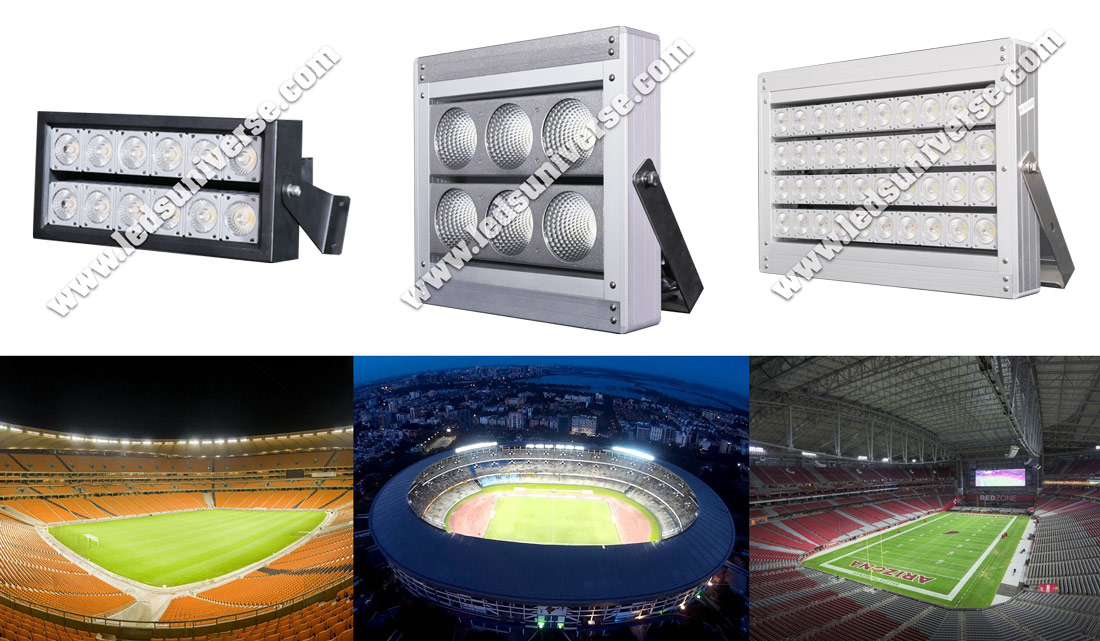
3. Why Should you Choose LED Lights to Replace Metal Halide Lights?
In order to understand how light is generated, it is important to understand two separate processes. The first happens before electricity reaches the LED light fixture, and can be regarded as a Powering Process. The latter takes place shortly after, with the projection of luminous output.
a. Powering Process or Power Consumption
By power consumption we mean the percentage of energy that is actually not wasted and is vital for turning on the fixture. In conventional lights and metal halides, 40 to 80% of energy is wasted during the powering process. With our LEDs, this value drops to less than 10%., meaning that our led stadium lights will require around 40 to 70% less energy for reaching the same lumen output than a metal halide lights for stadium.
b. Luminous Output Process
The luminance process is the second stage. After the light has been powered, it needs to project light intensity to the ground. Now, here it is important to distinguish between what is brightness and what is efficiency.
Metal Halide Lights
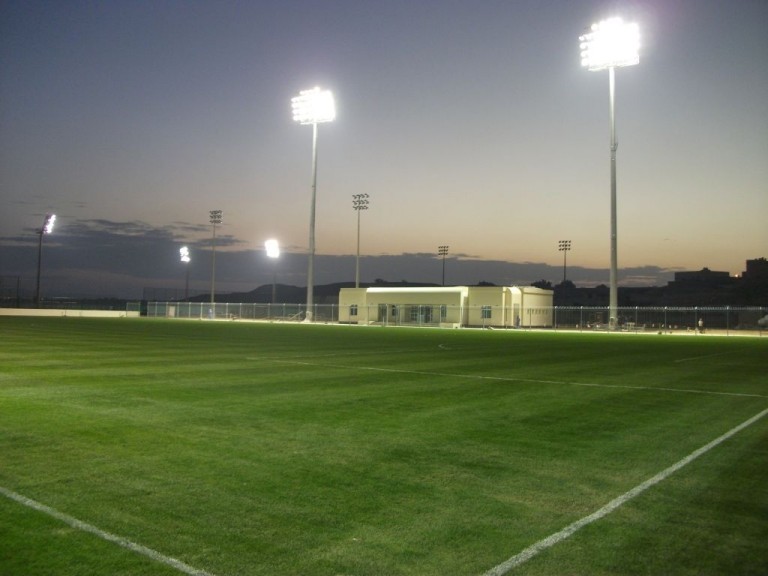
1. Lower Luminance Ground Reach: Much lower efficiency
2. Power Consumption is Higher: Only 20-60% of electricity is used in actually giving power to the lights. A lot of power is wasted in the process.
3. Low Power Efficiency Ballast (How it interferes with the overall electrical system): Only 60-80% of the voltage is counter-balanced in a correct way by the ballast. Meaning that the Power Factor is only 60-80%, what causes significant interferences on the overall electric current. If we imagine that an installation includes other electrical equipment besides just the lights, they will be affected more negatively than under LED.
4. Fragile: with high maintenance rate because they use glass tubes
5. Low Reaction Rate: Lights take around 1 minute to reach their full luminance potential
6. Anti-ecological and more potential Health Hazards: More usage of ultraviolet light
7. High Temperature: which causes light lost rate to become higher
LED Lights
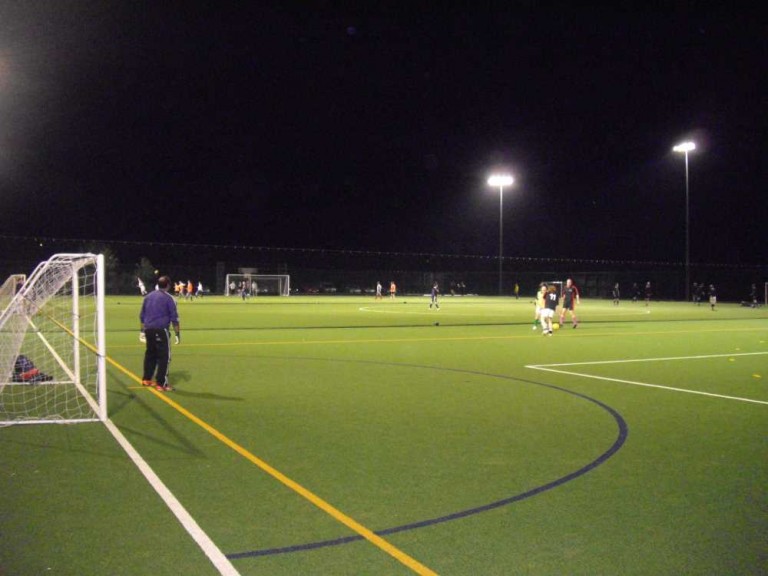
1. Higher Luminance Ground Reach (with LedsUniverse technology): With the 2 times + optics, and central beam radiance, we are able to have more light on the ground than conventional lights or even other LED manufacturers. This technology is much more than just the lm to W ratio.
2. Power Consumption is Lower: About 95% of electricity is channeled to power the light, and less than 5% energy is wasted. We can increase consumption efficiency a lot, by 3 or 4 times.
3. High Power Efficiency Ballast: LED has the SMPS (switch made power supply), leading to 95% voltage efficiency. It incorporates a capacitor that can redistribute and compensate better the voltage. This leads to more voltage stability and less interference on the overall electrical system (which includes other equipment as well).
4. Solid State Light: Shook Proof is Strong
5. LED lights reaction is faster: Switching speed is a mini-second. Instant on and off.
6. Clean and Eco light source: LED focus more on the spectrum’s colors that we can see, which means merely no UVs are used.
7. Cooler light source: which causes light lost rate to be lower. However, there is still room for improvement in this LED field
Summary: LED lights are the best for energy saving, while at the same time their good optics will lead to better lumen output efficiency, culminating in the increase of overall ground lux. The only drawback of led stadium lighting is that it might require some more initial investment, but after 6 months to 1 year, customers would already be saving a lot on energy. And after the 1st year and a half, the amount saved in energy has been enough to pay the initial extra investment. From then on, the LEDs will be generating revenue (a good cash-cow to have).
Conclusion: Currently, led stadium lighting is the best technology, as it is far superior to any other solutions in the market. LED is not the future, it is already the present!
4. Are High Power LED Stadium Flood Lights Very Efficient Fixtures Just for Being Very Bright?
The answer for this question is a simple no. What is more relevant for a led floodlight or for LED stadium lights is not only how bright their light might be, but how well and how far they can project that brightness. If a fixture is extremely bright during the first 10 meters, but its lighting intensity fades after that distance, the real lumen that will reach the pitch will be considerably low (especially taking into consideration that in stadium lighting, high mast flood lighting fixtures are mounted in high poles).
Therefore, instead of just highlighting brightness, what needs to be considered as well is how to make that brightness travel across a larger length and distance. Brightness is a relevant factor, but not the only one at stake
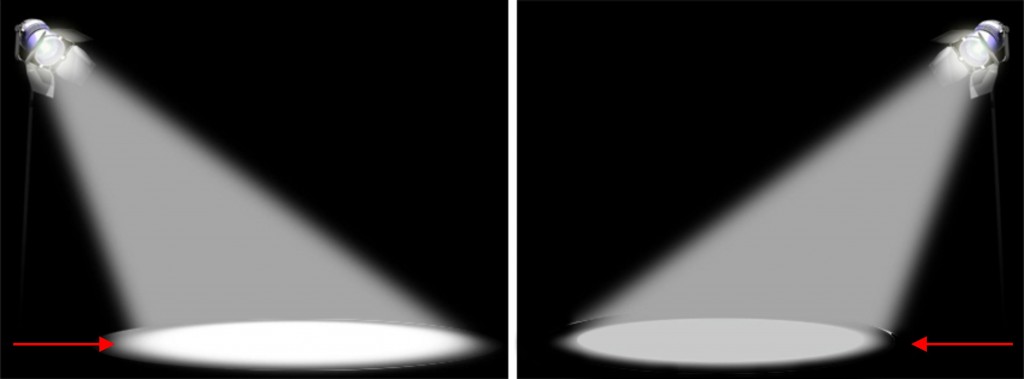
5. How Can This “Travelling Ability” be Achieved?
The key element for generating a high lumen reach is to carefully handle optics in led sports lighting. Geometric optics, which is the most common optical field, treat light as a collection of rays that travel in straight lines and bend when they pass through or reflect from surfaces.
So, when manufacturing and installing each of the lenses for a led stadium light, it is crucial to do a maximization analysis of how the light rays are leaving the junction, manipulate them to focus more in a certain direction (this is achieved by mathematical combinations and lighting software simulations made by our in-house engineering department). If the LED light rays are more concentrated, then less light will be spilled or wasted as it leaves the junction.
Through various experiments which we have done over the years, LedsUniverse came to realize that merging reflector with optics technology will lead to higher output reach ability for led arena lights, as the reflector hinders light from spilling out from the junction sides, whereas the optics maximize the “throw”.
In LedsUniverse, our expertise in producing extremely high-end optic lenses, has enable us to offer a luminance ground reach that is twice as strong as most our competitors. This reflects has an extra ground brightness of 50% on the LED stadium lights and on LED sports lighting for outdoor football pitches.
6. Stadium Lighting Design
Below follows some examples of led stadium design & installations we have done in the past. In order to provide more details, we will add pictures directly extracted from some of our Dialux studies aimed at lighting design.
For this first project, in which client needed football led stadium lights, the led fixture installed was our 1000 watt led flood light. There were 6 poles, each with a 16 meter height. 22 high mast lights were installed.
In this picture you can understand the size of the field (104m x 68m). Also, you can derive the total and high lumen per watt being reproduced, when all lights are grouped together. In this case, the total lumen per watt was 140,000.
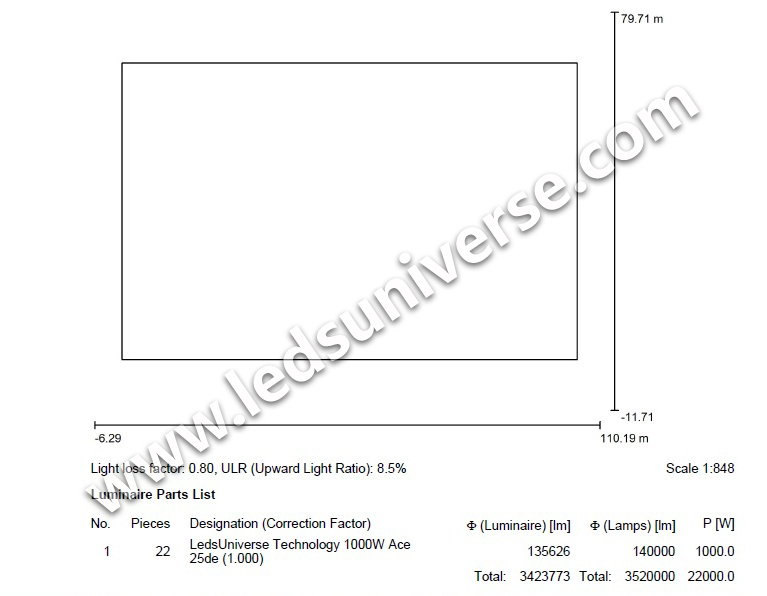
In the above picture the Dialux reveals the IES file being used, as well as its configuration. You can understand the led flood light wattage. We pride in saying that we are the led lighting manufacturers in China with better lumen output per light and more advanced optics.

In the picture below, you can understand how poles are distributed across the lines of the football pitch:
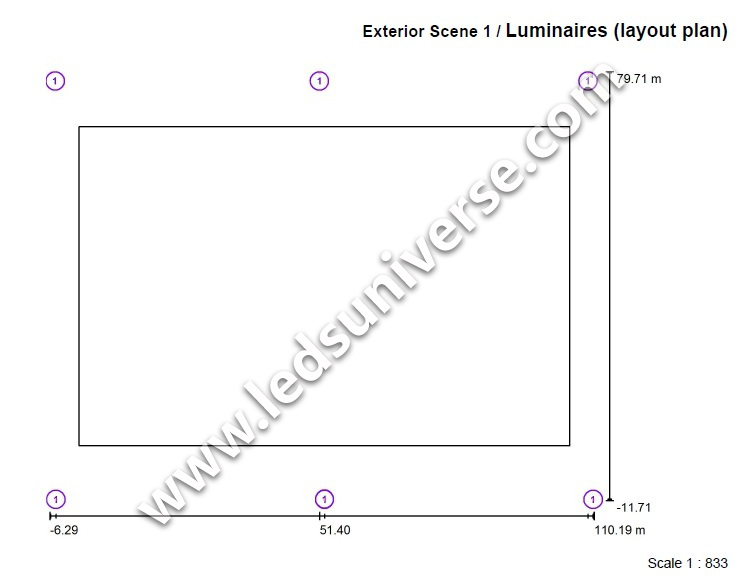
It illustrates of how many lights will be installed in each pole, as well as where each pole will be located. The X letter is the horizontal axis, meaning the football pitch ’s length; the Y represents the vertical axis, or the field ‘s width; lastly, Z symbolizes pole height (in this scenario pole height is always 16 regardless of the pole).
a. How Many Lights Mounted Per Pole?
Thus, in the figure below, Flood light number 1, 2 and 3 are mounted on the same pole because both values of X are the same. Equally, lights 7, 8, 9, 10 and 11 are mounted in another pole.
For this stadium, there are 4 masts (each with 3 lights), and 2 more poles (each with 5 more fixtures). The total is 22 units installed across the field.
b. Where are the Poles Located?
Pole number 1, which includes the high mast flood lights 1, 2 and 3, is located at the bottom left corner of the pitch, because X and Y are both negative values (X being negative goes to the left, and Y being negative moves down. That’s why it is in the bottom left corner).
High Mast number 3, with lights 7, 8, 9, 10 and 11 is at bottom center. X is a middle value (between the minimum -5.000 and the maximum 110.000, so it portrays a middle lighting pole). Y value is negative; therefore the mast is located on the bottom of the picture.
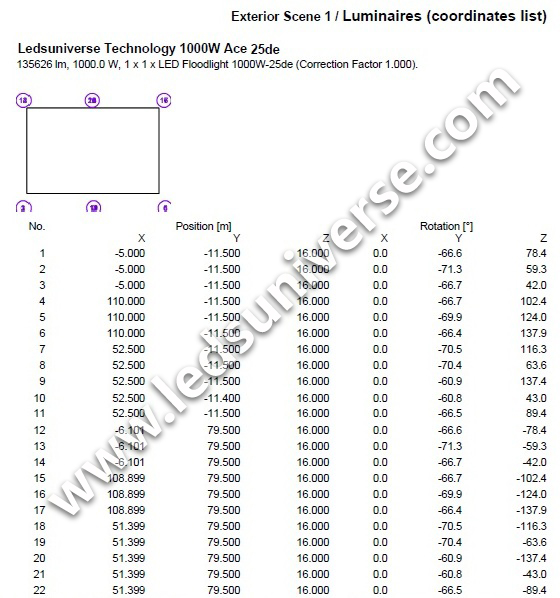
Some led light manufacturers in China focus too much on illuminating the central area with very few concerns to a balanced light distribution. This is essential for the field to be lit harmoniously. As you can see in picture number 5, the lux spread across the entire soccer field is very stable across different areas, making the overall pitch led illumination extremely balanced.
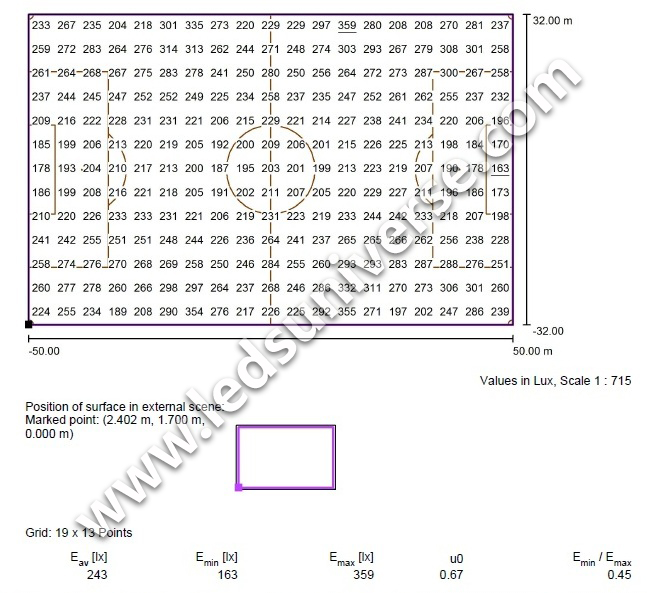
7. 1000W LED Stadium Flood Lamp Specifications
In order for you to understand the features of the lighting fixture we used, we are detailing here some important facts belonging to the datasheet for the 1000w flood light.
| Item | IP66 Waterproof Stadium LED Lamp |
| Item No. | LS-FLN1000-LITE-15 |
| Power | 1000W |
| Light Source | Bridgelux |
| Input Voltage | 90-265VAC 50-60HZ |
| Power Factor (PF) | ≥0.95 |
| Power Efficiency | ≥90% |
| Color Index(CRI) | Ra>65 |
| Light Angle | 10°, 25°, 40°, 60°, 90° |
| Color Temp | 2700-3500K 5000-6500K 6500-7500K |
| LED Luminous Efficiency | 140 lm / Watt |
| Luminous Flux (Typ.) | 140000 lm |
| Equal Flux (Typ.) | 280000 lm |
| Life Span | ≥80000 hours |
| Work Temperature | – 25 ° C ~ 55 ° C |
| Storage Temperature | – 40 ° C ~ 80 ° C |
| Working Humidity | 10 % ~ 90 % RH |
| IP Rating | IP66 |
| Light Attenuation (80000h) | 30% |
| Light Body Size (L x W x H) | 918.8 x 530 x 99.5 mm |
| Lamp Net Weight (kg) | 25 |
| Package Size | 1010 x 620 x 194 mm |
| Total Weight (kg) | 30 |
Luminance Indication
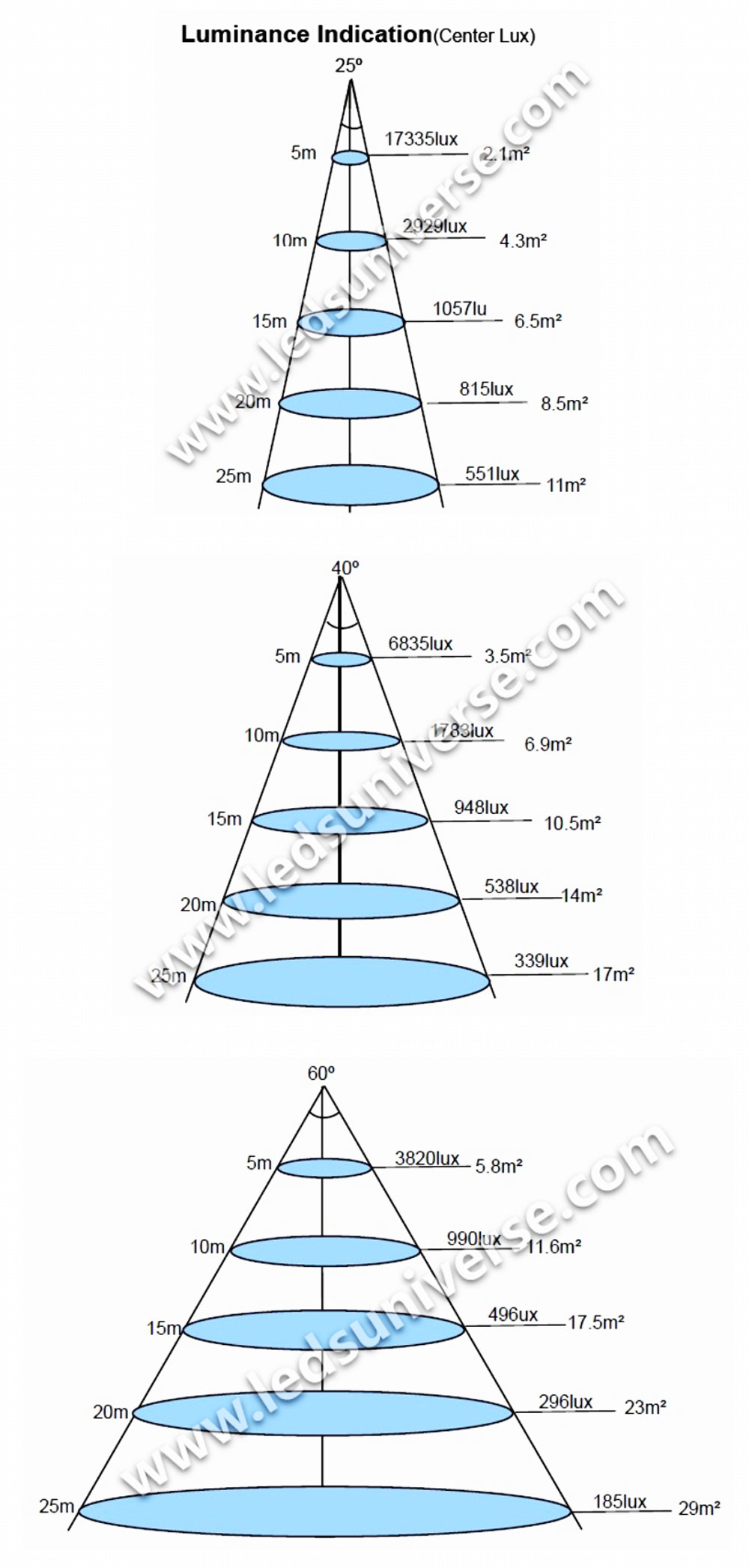
8. 1000 Watt LED Flood Light Test Report
Test Item: 1000W LED Flood Light
Test Company: Independent Laboratory Testing
a. Life Span Test Project
Test Method:
Light Fixture maintains bright in constant temperature and humidity environment, temperature range should be within 45+/-2 degree, relative humidity is no more than 60% ,wind speed is less than 0.05m/s. Light Fixture is driven of the constant temperature and humidity environment, adjust the ambient temperature to 25+/-2 degree. The measure it with power.
| Hour | Light Flux (lm) | DC Voltage (V) | DC Current (A) | Preservation Rate of Light |
|---|---|---|---|---|
| 1 | 110000 lm | 31.33 | 35 | 100% |
| 1000 | 107800 lm | 31.35 | 35 | 98% |
| 2000 | 107360 lm | 31.30 | 35 | 97.6% |
| 3000 | 106150 lm | 31.35 | 35 | 96.5% |
| 5000 | 104500 lm | 31.28 | 35 | 95% |
| 6000 | 103730 lm | 31.37 | 35 | 94.3% |
| 6500 | 102850 lm | 31.37 | 35 | 93.5% |
Estimated life Span:
According To energy star requirements for LED life Spain, light saving rate is 93.50% for 6500hours and life span is greater than 80000 hours
Failure Determined:
When retention rate is less than 70%, we regard it as led failure. The Visible brightness is observed obviously down, central color temperature shifts seriously, the basic lighting requirements for customers or Users cannot be satisfied, or it has bad effect to the eyes of users. Failure time: generally 100000hours
b. Opto-electric Test
Lamp Parameters:
| Input Power AC | Rated 1050W Measured 1049W |
| Power Factor | Rated 0.95 Measured 0.95 |
| Input Frequency | Rated 50~60 Hz Measured 50 Hz |
| Color Temperature | Rated 2800-7500K Measured 6750K |
| Luminous Flux | Rated 110000lm Measured 115400lm |
| Input Voltage | Rated 30-34V Measured 31.3V |
| Input Current | Rated 35A Measured 35A |
| Luminary Efficiency | Rated 130 lm/W Measured 135 lm/W |
| Color Index | Rated 65 Measured 70.5 |
Test Instruction:
1. The Luminous surface of fixture is horizontal.
2. LED Driver is inbuilt type.
3. Light Source: LS-HPEPY100M50CW-A11 10pcs
4. Keep the light on for 2 hours when measured; write down the numbers after the light source is stable
5. Test Environment temperature: 25+/-1C, Humidity: 61+/-10% RH
6. Photometric Test Condition: Use The Sphere- Radiometer to test optical and color. Parameters: Integrating sphere diameter-1.5, inner ball coating is barium sulfate, reflection rate 90-95%. Measuring method-4%, the spectrum range is 380-790nm
7. Uncertainty explanation: under impact from test environment and temperature, the system inaccuracy of testing instruments will further impact the test results.
Referred test standard: IES LM-78:2008, IES LM-79:2008, IES LM-80: 2008,US Energy star, LED TEST(Version 2),CIE 127:2007,ISBN 978 3 901 906 589
c. Light Source Test Report
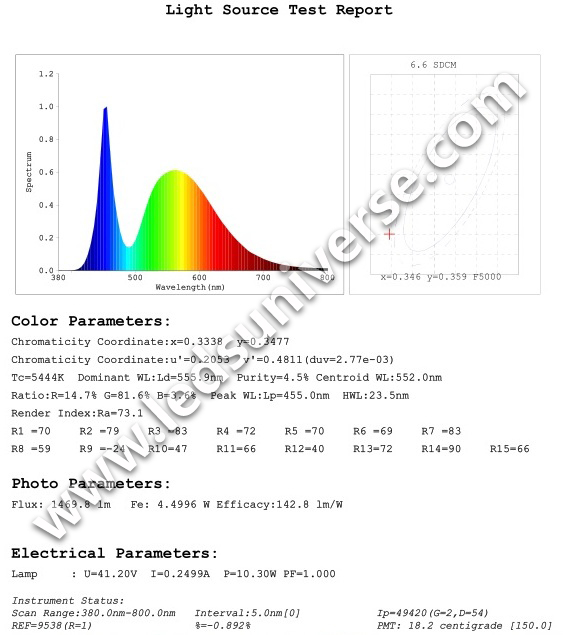
Picking the LED light with the right Technical Parameters and Lumen/Source Indication, which also has a good throw and projection of lumen into the ground, will increase your overall lux while making you save money in the process.
Chose LedsUniverse Technology mast fixtures, and be sure to have in your sports field world class led stadium lights.
Please feel free to contact us by filling in the info in the form. We are looking forward to your message.
